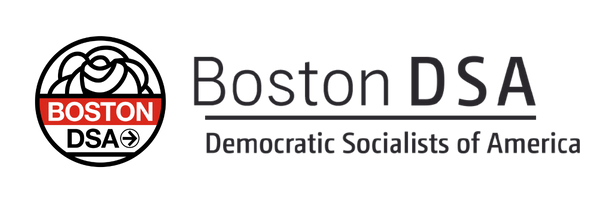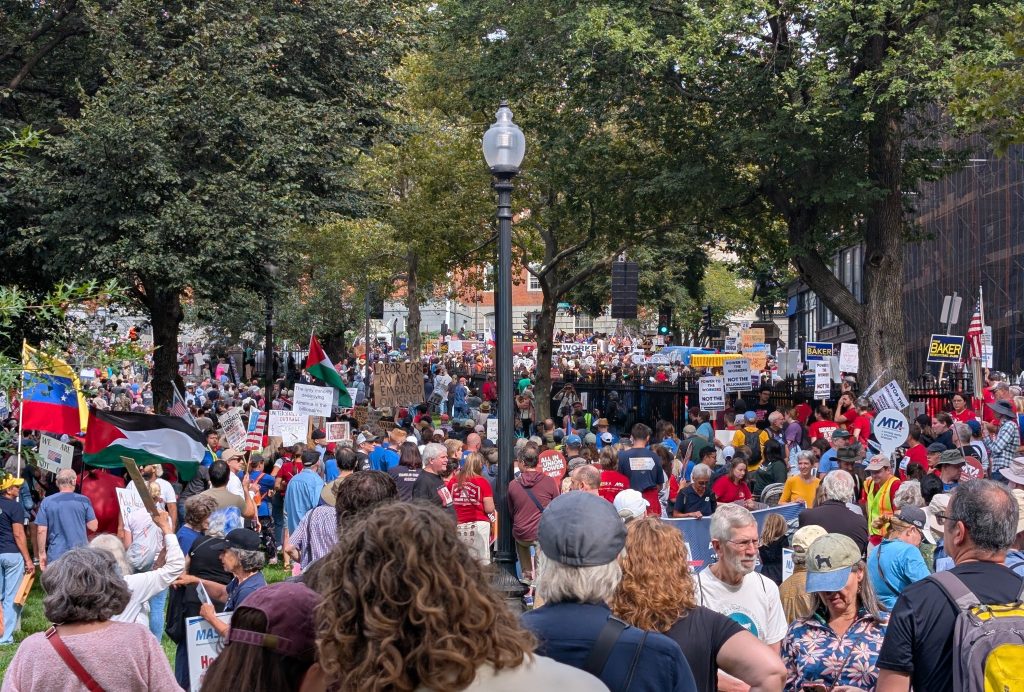[[{“value”:”

By: Andrew S
LAWRENCE, MA– Unionists and socialists gathered together at the Heritage State Park for the 41st Annual Bread and Roses Heritage Festival on September 1 – Labor Day. And as organizers from unions and mass organizations across the Merrimack Valley push in a renewed surge of organizing amidst a backdrop of labor repression, the specters of the Bread and Roses Strike watch on.
The Strike in the Trial of a New Society
First organized in 1985, the Bread and Roses Heritage Festival celebrates one of the most important events in American labor history – the Lawrence Mill Strike of 1912, colloquially known as the Bread and Roses Strike. At that time, Lawrence was inundated with textile mills that heavily employed and exploited immigrant and women workers. At the turn of the year in January 1912, the state of Massachusetts passed legislation to reduce maximum working hours for women and children from fifty-six to fifty-four hours. After a failed attempt to desperately fire half of their workforce of women with men, mill owners summarily reduced their wages instead. As socialist leader and militant railway worker “Big Bill” Haywood would later describe, Lawrence mill owners “[were] putting their thieving fingers into the envelopes of thirty thousand and from each and every envelope extracted 30 cents from every worker.” Thousands of women workers organized a successful walkout. They went on strike for three whole months in the ruthless conditions of a Merrimack Valley winter.
Strike efforts were largely led by workers with the militant Industrial Workers of the World (IWW), or “Wobblies,” who brought in heavy hitters for strike solidarity. Elizabeth Gurley Flynn, a tour de force organizing mine workers from the Midwest to the Pacific Northwest, accompanied the aforementioned “Big Bill” Haywood – a legendary labor activist who cut his teeth during the Colorado Labor Wars and emerged as an icon of labor and socialist organizing from Massachusetts to the American West. Flynn and Haywood joined IWW organizers “Smiling Joe” Ettor and Arturo Giovannitti on the road to Lawrence.

The strikers and organizers of the Bread and Roses Strike paid considerable costs. After a cop killed striker Anna LoPizzo on the picket line, Ettor and Giovannitti were arrested and later endured a two-month trial which author Justus Ebert would coin “The Trial of a New Society”, going beyond a conflict of capital and labor and placing thrusting old societal values into question. Ettor and Giovannitti were ultimately acquitted, but not without another strike on September 30 in which 15,000 workers would picket during their indictment hearing, along with worker boycotts from Sweden, France, and the Italian motherland from which so many Lawrence workers on strike had recently migrated.
History and textbooks have attempted to win a counternarrative or bury it altogether. One counterprotest organized for “God and Country” on October 12, in which counterprotestors espoused jingoistic and patriotic values in dissent of the thousands of workers who bravely struck that year. Their pathetic actions are memorialized by an even more pitiful flag mast toward the center of Heritage State Park. The Zinn Education Project also noted that ten out of twelve textbooks either have not written about the Lawrence Mill Strike of 1912 or have misrepresented its fight for workers.
However, for those who picketed and lost blood, sweat, tears, and more in those three months in 1912, the world changed. Those workers experienced an immense victory. The mills lost over $30,000 throughout the strike period, equal to almost a million dollars today when accounted for inflation. Material gains were enormous: wages of workers rose by fifteen percent, double pay for overtime was set, and a pledge for non-retaliation against striking workers was secured. Haywood declared that the Bread and Roses Strike was “a wonderful strike, the most significant strike, the greatest strike that has ever been carried on in this country or any other country,” crediting the victory most especially to the democracy the workers had organized and their success in bringing multiple nationalities together in the name of labor.
The Bread and Roses Heritage Festival celebrates one the greatest moments in American history and the radical potential the working class holds in the country’s darkest hours.

The Festival in the Now
In 2025, over a century after the Bread and Roses Strike, workers and their supporters gather in balmy weather under partial clouds. This isn’t the first time the people have gathered in Lawrence; this is the forty-first year of the Bread and Roses Festival. Organizers set up tables representing various organizations, from teachers unions, socialist parties, Palestine groups, anarchist organizations, and local businesses. Six local musical artists performed with various events speaking on labor and other left-wing organizational efforts happening across the Merrimack Valley and Massachusetts.
While the effort of the festival was to celebrate worker militancy, the current state of government affairs hovered in the clouds above. Merrimack Valley DSA, tabling and petitioning signatures for their Safe Communities Act campaign, rallied and held organizing conversations with workers and supporters who gathered around to discuss ICE attacks and their rampant rackets in kidnapping and detaining working-class immigrants throughout the state.
Local officials and candidates attended the festival to celebrate the festival’s history.
Marcos Candido, running for the District 8 seat of Lowell City Council and endorsed by Boston DSA, reiterated the need to celebrate victorious moments in labor history like the Bread and Roses Strike, especially given the fact that the strike was primarily organized by immigrant and women workers. However, today’s struggles are always at the front of Marcos’ mind.
Reflecting on the connection between 1912’s Merrimack Valley and today, Candido said:
Time is a flat circle in capitalist society. The only thing that really changes is the technology that carries out anti-union efforts and the cops who come at us looking like US soldiers fighting in the Iraq war. I think things have shifted a little, but people are working sixty- to seventy-hour work weeks today like they were back then. It is weird that in the year 2025, the eight-hour workday is still in demand because even though the forty-hour work week is the standard, in any city it is not enough to survive. People have to work two, three jobs and still don’t have enough to pay their bills. Unfortunately, a lot of the demands of then are the demands of now. The capitalists have the power and use their power to regress.

While the labor movement today has yet to organize a strike as historically pronounced as the Bread and Roses Strike of 1912, labor unions and mass organizations like DSA look to build the power required and beat fascism with socialism. The Bread and Roses Heritage Festival gives the working class another space, deep in the Merrimack Valley on the hollowed grounds of labor history, to take the lessons of this action and move forward.
If Candido wins his seat in Lowell, he intends to fortify his dedication to serving working-class immigrants. “The Safe Communities Act that DSA is pushing for is really important, and even if it doesn’t pass at the state-level or in Boston, making sure that something like that is passed at the local level is extremely important,” said Candido. “Just like Lawrence, Lowell is a large immigrant community. Everything that is happening at the national level is worsening. Immigrants are getting attacked more and more, as well as union leaders and workers.”
“From Lawrence to Lowell, It’s incredibly important that city councils make sure every working family is protected and gets to live a good life,” Marcos Candido said.
Andrew S is an organizer with Boston DSA and contributor to Working Mass.

Workers Over Billionaires: Boston’s Historic First Labor Day Parade
By: Maxine Bouvier
BOSTON, MA– Local labor unions and their allies gathered on Monday, September 1 for a historic celebration of workers rights: Boston’s first ever Labor Day Parade. Organized by the Greater Boston Labor Council, a statewide affiliate of labor’s largest federation working to organize across different unions in the Boston area, the event featured speakers and contingents rooted in a variety of labor struggles.
Those present included teachers, healthcare workers, postal workers, municipal employees, app drivers, actors, transportation workers, tradespeople, and more. In addition, union members were joined by ally organizations including Boston Democratic Socialists of America (DSA), Massachusetts Peace Action, MassCare, and the American Civil Liberties Union (ACLU).
The event’s central slogan was “Workers Over Billionaires” and began with speeches from union organizers and political leaders to the crowd gathered on Boston Common, highlighting the power of working people and the urgent need for continued organizing. Thousands stood together, with each union represented with its own assembly. Present were teachers, healthcare workers, postal workers, municipal employees, gig workers, actors, transport workers, and tradespeople. Ally organizations like Massachusetts Peace Action, MassCare, and ACLU brought their contingents, as well. Boston DSA was represented by over fifty members wearing red shirts marching in solidarity with signs that read “Socialism Beats Fascism.”

Chrissy Lynch, president of the Massachusetts state federation of the AFL-CIO that bottomlined the parade, said to roaring cheers:
It is the working class that is the backbone of America, not the billionaire class. The rights we celebrate on Labor Day are being ripped up. Working class people are anxious about our jobs, about paying our bills, and if our neighbors are going to be ripped off our streets.
This sentiment was reflected in the signs of protestors present – many called for the inclusion and protection of undocumented immigrants currently targeted by the Trump administration’s increasingly aggressive deportation program. The parade marched from Beacon Street through downtown to City Hall Plaza. Along the route, attendees chanted and sang, calling for solidarity and a continued fight for workers’ rights. People laughed, cheered, and roared chants.

“Money for jobs and education, not for war and deportation,” called members of the Boston Teachers Union. Tracy Romain, a member of the Boston Teachers Union (BTU), shared what felt most important to her about organizing with her colleagues: “[It’s about] bringing everyone together, bringing our wages up, getting what we deserve. Fighting for our rights, and for democracy.” BTU Local 66 emphasized the need to stand up for public education as funding cuts are threatened.
At City Hall Plaza, more organizers spoke about their ongoing fights for better working conditions. A representative of concession workers at Fenway Park, organizing under UNITE HERE Local 26, spoke about their current efforts and a recent two-day strike:
These machines that are replacing us don’t have a family, a neighborhood, or a Boston accent. When we strike again, we will not have an end date. We will not surrender to your low wages and increases in automation.
Many union members shared similar grievances. A speaker from Mass General Brigham’s Primary Care Physicians Union shared that MGB has refused to recognize their right to bargain. Similarly, a representative of the newly formed App Drivers Union spoke about the difficulty of fighting for recognition from corporate leadership:
Today, for the first time ever, ride share drivers are standing with their fellow workers on Labor Day, on the verge of winning the first ever app drivers union in the United States… when working for these companies can feel like living under dictatorship.
While acknowledging the realities of these shared difficulties, the Labor Day Parade and rally were uplifting in tone – a reminder of the power of the working class, what dedicated organizers and unions have already won, and the work that still needs to be done.
Maxine Bouvier is an organizer with Boston DSA and contributor to Working Mass.

The post Labor Day 2025: From Lawrence’s Bread and Roses Festival to Boston’s Historic First Labor Day Parade appeared first on Working Mass.
“}]]

